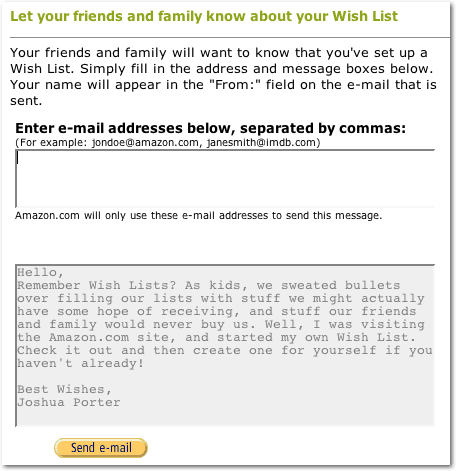Amazon Wish List Sharing gets it Wrong
Before anybody claims that I am an Amazon fanboy (as I reference Amazon *a lot* in my talks), let me just say that in addition to some really great design they also have areas to improve on. Here’s a particularly baffling one: wish list sharing.
Sharing is crucial in social design. It allows people to share your application/service/web site with others in a way that you as the designer can’t. What other people say about you is an order of magnitude more powerful than what you can say about you.
If you don’t have smooth, easy process for sharing you are hampering the growth of your app. Sure, people will share to some extent on their own, but why force them to? When someone sends a personal, relevant message sharing something, the recipient will take notice. Make that as easy as possible.
Here is the sharing form for Amazon’s wish lists. It’s a typical sharing form: a bit of explanatory text, an email field, and a message.

But for some reason, and I can’t for the life of me figure out why, Amazon doesn’t let you edit the message. And they really should, as the message suffers from several problems…
Before anybody claims that I am an Amazon fanboy (as I reference Amazon *a lot* in my talks), let me just say that in addition to some really great design they also have areas to improve on. Here’s a particularly baffling one: wish list sharing.
Sharing is crucial in social design. It allows people to share your application/service/web site with others in a way that you as the designer can’t. What other people say about you is an order of magnitude more powerful than what you can say about you.
If you don’t have smooth, easy process for sharing you are hampering the growth of your app. Sure, people will share to some extent on their own, but why force them to? When someone sends a personal, relevant message sharing something, the recipient will take notice. Make that as easy as possible.
Here is the sharing form for Amazon’s wish lists. It’s a typical sharing form: a bit of explanatory text, an email field, and a message.

But for some reason, and I can’t for the life of me figure out why, Amazon doesn’t let you edit the message. And they really should, as the message suffers from several problems:
- This form literally puts words into people’s mouths, as they can’t change the text.
- The copy-writing is painful. It creates a fake history for the person and sounds like it was written by someone desperate to make a sale.
- “create one for yourself”??? This is a good example of focusing on social value instead of personal value. (ala the Del.icio.us Lesson)
- It is obvious that nobody would write this to a friend or family member. Do friends or family members sign their last names? No.
This bizarre design choice on Amazon makes the act of sharing a wish list impersonal, thereby killing most of the effect. Not only do you lose the identity of the sender, but you can’t set any context for the email at all. You can’t say “Hey Mom, here’s the Wii game I was talking about” or “Hey Grandma, instead of sending me ugly sweatpants of the local sports team send me these books”. After reading this message several times I keep thinking “who would ever send this?”. What context would this fit?
Simply put, any advantage you could gain by allowing people to send a wish list in their own identity is lost. As Charles Eames said: “The details are not the details. They make the design.”
Update: A member of the Amazon Wish List team says:
“The text of this email has been locked temporarily for security reasons until we can implement a better solution.
The timing before the holidays is quite unfortunate.”
(editor’s note: drop me a line if you find this type of post useful…I have *lots* of these examples)